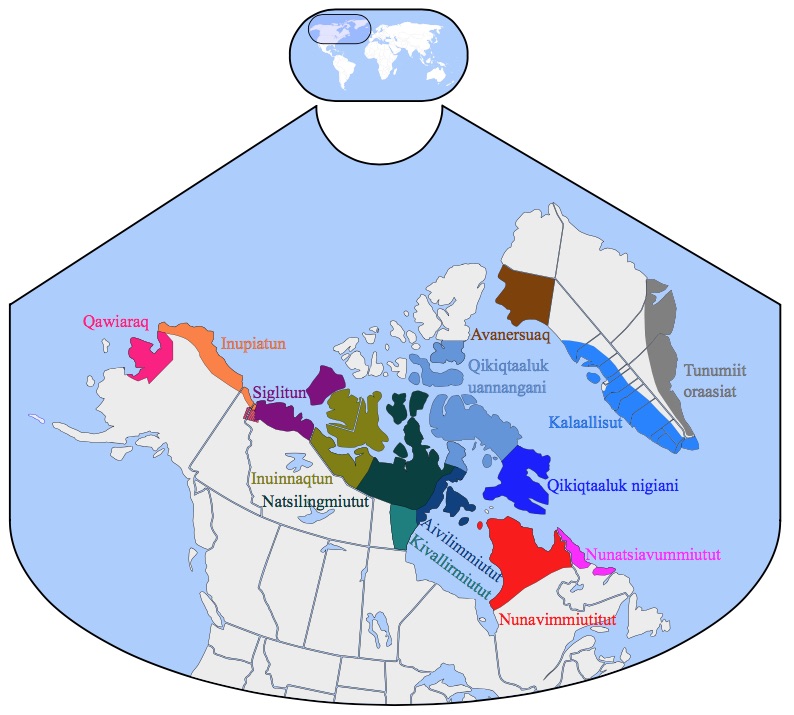Quick links
Inuktitut
DCHP-2 (Jul 2016)
n. & adj. — Northern Canada, Aboriginal (Inuit)
any of the many related dialects spoken by the Inuit.
Type: 4. Culturally Significant — About 75% of the Inuit living in Canada, mostly from Nunavut or Quebec, report that they speak Inuktitut. Thus the language has special cultural significance here (see Tusaalanga reference). The name Inuktitut is often applied to the whole range of closely related Inuit dialects including those of Alaska and Greenland (see Image 1). The names of the various dialects and sub-dialects have varied over time and the spelling is not yet stable. In Labrador, the local dialect is called Inuttut, Inuttitut or Nunatsiavumiuttut. In Nunavik (northern Quebec), Inuktitut is used. In Nunavut, two dialects are now official: Inuktitut, written mainly in syllabics, and Inuinnaqtun (Copper Inuit), which uses a Roman orthography. Dialects of the western Arctic (e.g. in the Mackenzie Delta) are known as Inuvialuktun. These dialects form a continuum, that is, those found close together geographically are mutually intelligible. However, speakers of the dialects that are most distant geographically find it more difficult to understand each other.
In Europe, the Germanic and Slavic languages form continua across national territories; these varieties have been given distinctive names in the course of history (e.g. Dutch, German), which has contributed towards their (distinct) development. Similarly, some dialects of Inuktitut have their own names, although these are not often found in mainstream publications. Although some are given official recognition, their institutional backing is recent compared to that of those European dialects which became standardized national languages.
In Europe, the Germanic and Slavic languages form continua across national territories; these varieties have been given distinctive names in the course of history (e.g. Dutch, German), which has contributed towards their (distinct) development. Similarly, some dialects of Inuktitut have their own names, although these are not often found in mainstream publications. Although some are given official recognition, their institutional backing is recent compared to that of those European dialects which became standardized national languages.
See: Inuit(meaning 3)
Quotations
1977
Another workshop participant, Aani Palliser of the Inuit Tapirisat of Canada, expressed frustration with her two-year unrelenting crusade to press the CBC to do more. ITC wants no less than two hours a day of Inuktitut.
1987
The word Inuit stands for "the people" (thus the show title) in Inuktitut, the universal language of the Inuit. Today in Canada, 23,000 -- almost a quarter of the entire Inuit population -- live in and around trading posts in Quebec, Labrador and the Northwest Territories. (Inuit also live in Alaska, Siberia and Greenland.)
1998
Mosher, present at the opening ceremonies, signed the wall with a note in English and in Inuktitut syllabics.
2000
here is a standardized Inuktitut transliteration, but not everyone knows it, or uses it. There are only three computer fonts for Inuktitut syllabics. Anything written in syllabics must be in Unicode, an international standard accepted by major computer manufacturers as a way to represent all written languages unambiguously. It uses two bytes to represent one character, and can represent 65,000 unique glyphs.
2003
The CME [Canadian Military Engineers] greeting or toast is "Chimo" - pronounced Chee-mo (with emphasis on the first syllable). This expression is also often used as a closing on correspondence between Engineers. The word Chimo is derived from the Inuktitut greeting: "saimo" (saimu) that means "hello," "goodbye," "peace be with you," and similar sentiments.
2008
Unlike coastal Inuit who hunted seals and walruses and had contact with explorers and whalers over several centuries, the nomadic people who depended on migrating caribou were isolated from European contact until almost the 20th century. Change came slowly. There was, for instance, no school in Baker Lake until 1959.
The exhibit includes snow knives made from caribou antler, dog whips of braided caribou skin, Henry Ford's fish spear, snow goggles, a water bucket and ladle made from caribou skin, and many other tools and implements. There are dolls with stone faces and caribou clothing, and intricate beadwork showing that almost everything the Inuit crafted was decorated as a matter of course.
"There is no word for 'art' in Inuktitut," says Ford. "Things were always made in a beautiful way."
2011
If white people can examine Inuit culture through the lens of science or anthropology, he reasons, then there ought to be an Inuit science of studying white people, known as Qallunaat in Inuktitut. Everything from etiquette - Qallunaats' passion for inane salutations and meaningless small-talk, for example - to the relentless quest to "keep up with the Joneses," to their need to repress natural bodily functions. In 2006, he teamed with filmmaker Mark Sandiford to create the Gemini-award-winning NFB docu-comedy Qallunaat! Why White People are Funny.
2016
When the World Went Online, Inuktitut Followed
Nunavut’s language experts looked to the past to invent new words for the digital age. “Meet the North,” a series that ventures into the lives of some of the 4 million people who call the Arctic home, learns how a language stays strong in the Facebook era.
Nunavut’s language experts looked to the past to invent new words for the digital age. “Meet the North,” a series that ventures into the lives of some of the 4 million people who call the Arctic home, learns how a language stays strong in the Facebook era.
References
- Tusaalanga reference • "What is Inuktitut?"
Images
